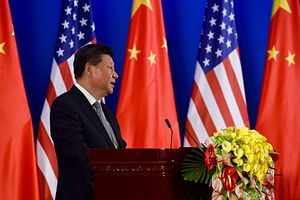On Thursday evening in the United States, U.S. President Donald J. Trump finally spoke to China President Xi Jinping for the first time on the phone since his inauguration on January 20. The two leaders had previously spoken on November 14, days after Trump had emerged the winner in the 2016 U.S. presidential election.
According to the Financial Times, which was the first to report on the call, Trump told Xi that the United States would respect its long-standing “One China” policy (distinct from China’s own “One China” principle). Surprisingly, the FT also adds that Trump told Xi that “he would abide by the diplomatic formula that Beijing and Taipei agreed in 1992” — referring to the so-called 1992 consensus.
A White House readout of the call noted that the two leaders had a “lengthy telephone conversation” and “discussed numerous topics.” Trump, per the readout, “agreed, at the request of President Xi, to honor our ‘one China’ policy.” The readout did not mention the 1992 consensus.
The Chinese Foreign Ministry has not released any statements or commented on the call as of this writing. The call breaks a spate of relative silence in the U.S.-China relationship since Trump’s inauguration and comes after Trump sent Xi a letter offering greetings for the recently concluded Lunar New Year Holiday.
Trump’s affirmation of the “One China” policy would place him in line with U.S. presidents going back to Jimmy Carter. The move will draw a sigh of relief from China, which feared that the Trump administration would consider a break with U.S. status quo policy on Taiwan, which is governed by the Taiwan Relations Act, and potentially move away from the “One China” policy.
U.S. non-affirmation of the “One China” policy could have led to a long-term diplomatic freeze, while renouncing the policy in favor of recognition of Taiwan as a state would have likely led to China ending normal diplomatic ties. No state has formal diplomatic ties with both China and Taiwan.
For an idea of how important assurances of continued U.S. compliance with the “One China” policy are to China, consider multiple accounts note that previous U.S. presidents had to recite an affirmation of the “One China” principle before any official call with their Chinese counterpart. Without this affirmation, the highly formal Chinese side would refuse discussions.
Trump’s phone call with Tsai took place in early December 2016 and rattled Beijing, which ultimately ended up publicly chiding the Taiwanese president for playing a “little trick,” but did not publicly rebuke Trump, who was then still a president-elect in the midst of a transition.
The point about the so-called 1992 consensus coming up in the Trump-Xi call is interesting and raises the possibility that Trump may have ushered in change to U.S. policy, but away from what Taiwan or Tsai might want. To date, the United States has taken no position on the highly ambiguous 1992 consensus — an agreement between the governments of Taiwan and China that acknowledged that there exists only “One China,” while leaving open the question of what exactly that means.
In the contemporary context, the 1992 consensus emerged as a sharp wedge between Taipei and Beijing last May, when Taiwanese President Tsai Ing-wen of the independence-leaning Democratic Progressive Party refused to explicitly affirm her support for the agreement in her inaugural address.
China was so upset over Tsai’s refusal to acknowledge the 1992 consensus that cross-strait communications were temporarily suspended. Tensions remain high between the two sides as of early 2017, with Yu Zhengsheng, a high-ranking Chinese Communist Party official, recently warning that cross-strait ties would grow “even more complex and grim” in 2017.
If Xi managed to get an assurance on the “1992 consensus” from Trump, it would represent a break with previous U.S. policy, but in a way that benefits China more than Taiwan. China continues to expect that Taiwan and Tsai Ing-wen’s government will abide by the 1992 consensus.
Finally, what makes the timing of the call more interesting is that it came hours after U.S. Pacific Command confirmed an “unsafe” aerial encounter with a Chinese military aircraft in the skies near Scarborough Shoal in the South China Sea — raising the possibility that Trump may have broached this issue with Xi.
The call additionally comes just hours before Japanese Prime Minister Shinzo Abe is expected to touch down in Washington, D.C., for his first state visit with Trump. China sent its coast guard earlier this week to patrol waters around the Senkaku/Diaoyu Islands, which it claims in the East China Sea and are administered by Japan.
The China Coast Guard vessels entered the waters just days after Trump’s defense secretary, Jim Mattis, left Tokyo after explicitly affirming that U.S.-Japan alliance commitments extended to the Senkakus.
Despite this, regional states will nevertheless rest easy knowing that Trump has chosen to affirm the United States’ old “One China” policy, seeing it as a sign of reassuring continuity after uncertainty during the transition. While the potential for instability remains between the two countries — especially given that Trump is surrounded by advisers that take a hawkish stance on China — the call will mollify the possibility of a sudden crisis erupting between the United States and China in Trump’s early days in office.
Bonus: Listen to the Diplomat’s editor-in-chief, Shannon Tiezzi, join me for a discussion on U.S.-China relations under Trump on the Asia Geopolitics podcast.
































